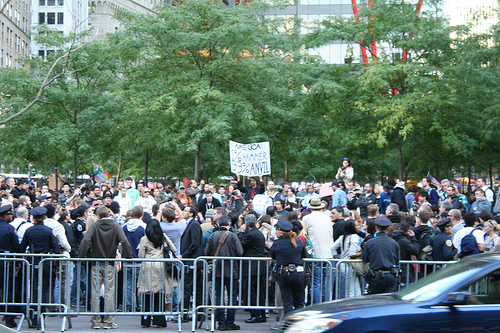Occupy Wall Street as a postmodern critique: On deconstruction, discourse, and a relative approach to truth
While some criticise the Occupy Wall Street movement for a lack of objectives, I see the protests fit perfectly within a postmodern framework. As such, I join the conversation in deconstructing what the events mean to me.

A postmodern definition
The above tongue-in-cheek depiction aside, I find three characteristics frequently used to describe postmodernism:
1. Deconstruction
Postmodernism is characterised by deconstruction, typically applied towards anything that sets itself up as an all-encompassing “grand narrative”. Society creates stories around that which is collectively agree as “truth”. Examples include a commercial mandate that demands progress, artistic or architectural prescriptions around shape and form, or religious beliefs that pervade into social and political convention. The postmodern approach rejects this truth and deconstructs these assumptions.
2. Discourse / dialogue / conversation
Deconstruction occurs within a dialogue relative to the individual. Language is an important focus, as the combination of words into speech is a grand narrative in itself. Deconstruction of a grand narrative such as capitalism needs to consider how our speech patterns have evolved to support that narrative.
3. Relativity
Once the grand narrative is rejected, the only perspective remaining for this deconstruction and discourse is from a perspective of the individual. Truth becomes relative. Absolute truth can only be possible through discourse, but then that truth is absolute only to those in the conversation.
Explained through the commercial mandate
It may be easiest to explain using an example of what postmodernism is not. Applied towards the narrative of capitalism, postmodernism can be described by comparing approaches to the three characteristics.
First, postmodernism deconstructs without a clearly defined end. Indeed, deconstruction can be seen as the end in itself. Capitalism on the other hand deconstructs towards an end of progress. Deconstructing embedded culture and “unfreezing” established patterns are critical steps in corporate change programs that have objectives of increased profit.
Second, discourse in the commercial framework is just as critical as it is in the postmodern. However, the conversation is on-topic towards fulfilling the profit motive of the commercial entity. Media, press, and news communication channels all support the notion that growth is good and commercial failure is intrinsically linked with personal failure. Conversations from corporations are one-way. Inferred two-way conversations are an illusion. Responses from the masses that do not satisfy the profit motive are deemed irrelevant.
Third, everything is relative to profit. The identity of the individual is isolated to “consumer” and “target audience”. Any truth relative to the individual is only relevant insomuch as it satisfies or does not satisfy the profit motive.
The Occupy Wall Street movement rejects the capitalist depiction, and does so with ambiguous postmodern aplomb.
The Occupy Wall Street movement as the perfect postmodern critique

The Occupy Wall Street movement originated publically with protestors in the Wall Street financial district of New York City. The demonstrations are united around discontent with the economic system, typified in the slogan “We are the 99%” that refers to the gap between the masses and a wealthy one percent of the American population. The movement has been replicated internationally at the local level, including Australian versions at Occupy Melbourne, Occupy Sydney, Occupy Perth, and Occupy Brisbane.
The correlation of the movement as a postmodern critique was clearly articulated by media theorist Douglas Rushkoff.
- In relation to deconstruction as the end goal, the movement “does not take its cue from a charismatic leader, express itself in bumper-sticker-length goals and understand itself as having a particular endpoint”.
- Touching on discourse, the movement “just sits there talking with itself, debating its own worth, recognizing its internal inconsistencies and then continuing on as if this were some sort of new normal.”
- The movement’s lack of single purpose highlights the relativity of the movement, as “different people have been affected by different aspects of the same system — and they believe they are symptoms of the same core problem.”
A clear distinction can be made with the Republican-centric American Tea Party movement, which sets itself a grand narrative to fight anything that “challenges the security, sovereignty, or domestic tranquillity of our beloved nation, the United States of America.” Such a clear mandate is a double edged sword, in that it is just as easy to support as it is to critique.
Occupy Wall Street has no such mandate. Indeed, at the time of this writing, Occupy Brisbane’s mission statement stated “The mission statement is currently being drafted and voted on in the General Assembly each day. Once this document is finalised it will be posted here.” This is not to say they are not organised, with Occupy Sydney’s website proposing 24 committees and groups.
Postmodernism as a grand narrative
The question then is how long can a movement, no matter how well organised, maintain momentum with no end goal? How long will discontent alone sustain a passionate deconstruction? Is the expression of frustration enough an objective to sustain effort and bring change to the capitalist machine?
One challenge with such a postmodern critique is that I do not see how postmodernism in itself can avoid becoming a grand narrative. At some point the organisation of the movement will give way to institutionalisation, promote leadership and hierarchy, power imbalance, norms of behaviour, and ultimately a more defined purpose for being. As soon as the machine of society can clearly articulate what the movement stands for, that machine will adjust to both defend and placate only to the extent that it can continue with the existing narrative.
A second challenge is that the movement is fighting established power without a power base itself. The machine can wait it out from the comfort of boardrooms while the demonstrators will at some point need to pause to use the toilet and grab a bite to eat. The machine has power and time to wait out the protest through what may appear to be an indifferent voting system.
The machine may lose a CEO or two and there may be some concessions on pay gaps. However, I do not believe the movement will see significant change so long as the underlying narrative of commercial progress is partnered with the human condition of competitive greed.
My position
Please do not misunderstand my views for criticism of either side. I see the current situation as the inevitable pendulum swing between states of compromise and moderation. The speed and angle of the pendulum can be predicted by the collective tension at experiencing the events as they unfold.
I see the personal and environmental destruction that results from a pure profit motive. I also observe the futility of a postmodern critique. From this perspective I openly participate within the commercial mandate with a belief that I might someday have greater influence of the outcomes from within.
The machine listens to its own before it listens to the fringe rabble. Examples of those working within the system include socially-minded commercial endeavours such as micro-lending organisation Kiva or “one for one” footwear provider TOMS Shoes. I do not deny the expression of frustration and disillusionment of the protestors, but I wonder if the sheer volume of human capital gathered around the globe would be more effective to produce an expression of critique within the system.
This is my deconstruction as I see it. Please feel free to engage in discourse below. I welcome the opportunity to explore the truth of the situation as it is relative to you.


And following on from the post, statements from the 1%, many who are not there by action or choice. http://bit.ly/nrZTM0